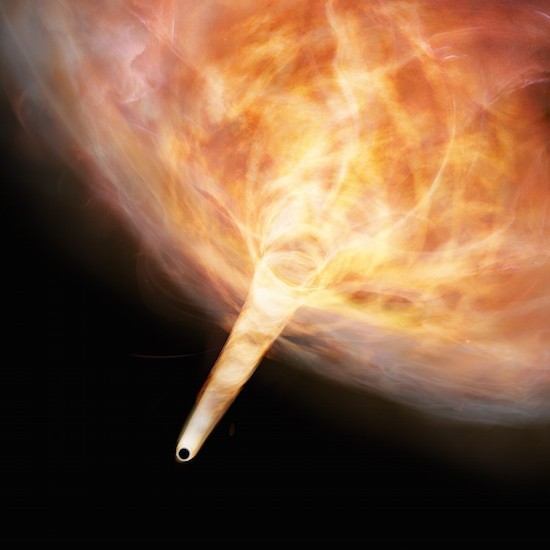By Ana Verayo, | February 03, 2017

Artist’s impression of a stray black hole storming through a dense gas cloud. The gas is dragged along by the strong gravity of the black hole to form a narrow gas stream. (Keio University)
Astronomers have detected a mysterious, lone black hole lurking around our Milky Way galaxy that scientists suggest is a "stray" black hole.
Black holes can appear or work differently, and not all of them can form an accretion disk that can reflect radiation. If there are no visible emissions, black holes remain mysterious cosmic structures that appear invisible and filled with dark matter.
Like Us on Facebook
In this new study, scientists were able to identify this stray black hole with the help of a supernova remnant known as W44, located 100,000 light years away from our solar system. The astronomers from Keio University in Japan were hoping to obtain measurements of how much energy is emitted by the supernova explosion into the surrounding gas clouds.
As the Japanese scientists were studying the supernova's molecular gas using the Nobeyama Radio Observatory's radio telescope, they detected an anomaly or an unexpected movement with velocities that are not possible in such conditions. The team identified this gas cloud that they call "Bullet" which possesses a funnel that rotates 62 miles per second. This cosmic structure is also spinning in the opposite direction of the Milky Way galaxy.
According to Masaya Yamada of Keio University, this kinetic energy is at least 10 times larger than the overall energy emitted by the W44 supernova. This appears to be impossible, as this energetic cloud generates so much energy under ordinary environments.
The researchers were able to build two models to demonstrate their theories about this intergalactic molecular gas behavior.
The first theory involves how a stream of gas is ejected by a stellar explosion from a supernova and when it passes through a black hole, its acceleration increases in high speeds due to powerful gravitational forces. This black hole is also estimated to be 3.4 times larger than our sun.
The second theory involves how this mysterious, lone black hole suddenly emerges and rams into the energetic molecular gas clouds of W44, which, in turn, spins this cloud mass into a highly dense stream. This black hole is also estimated to be around 36 times larger than the sun.
To date, only 60 black holes have been detected inside the Milky Way. However, some models suggest that there are an estimated 100 million to 1 billion black holes populating our galaxy alone.
This new study was published in the Astrophysical Journal Letters.
-
Use of Coronavirus Pandemic Drones Raises Privacy Concerns: Drones Spread Fear, Local Officials Say

-
Coronavirus Hampers The Delivery Of Lockheed Martin F-35 Stealth Fighters For 2020

-
Instagram Speeds Up Plans to Add Account Memorialization Feature Due to COVID-19 Deaths

-
NASA: Perseverance Plans to Bring 'Mars Rock' to Earth in 2031

-
600 Dead And 3,000 In The Hospital as Iranians Believed Drinking High-Concentrations of Alcohol Can Cure The Coronavirus

-
600 Dead And 3,000 In The Hospital as Iranians Believed Drinking High-Concentrations of Alcohol Can Cure The Coronavirus

-
COVID-19: Doctors, Nurses Use Virtual Reality to Learn New Skills in Treating Coronavirus Patients







